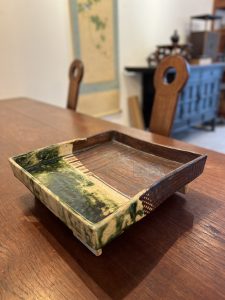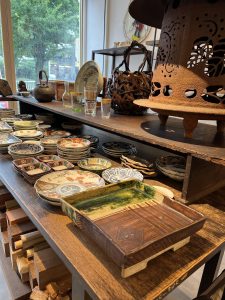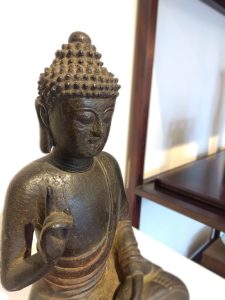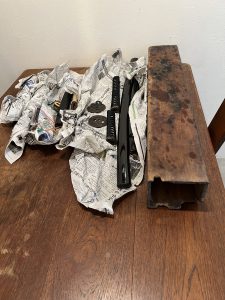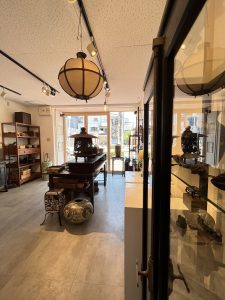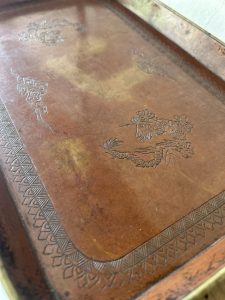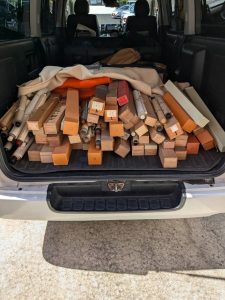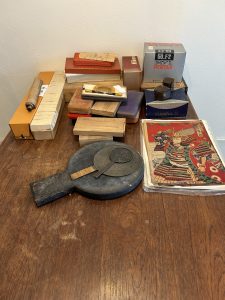柔らかい輝きの錫の魅力(愛知県名古屋市千種区姫池通 骨董買取 古美術風光舎)
2024.09.01
皆さまこんにちは。スタッフHでございます。
最近の私の朝の日課はパラリンピックの録画を観ることと、台風の進路チェックです。
パラリンピック選手たちの活躍に思わず見入ってしまうため、今朝も遅刻しそうになりました。個人的には「ボッチャ」を楽しみにしております。
台風といえば毎日、こんなところに⁈という場所に居座っていて驚かされます。今朝は太平洋上にいらっしゃいましたね。まるで思春期の子供に翻弄されている気分になります。実際のところ今回の台風10号は香港の少女の名前に由来する「サンサン(shansahan)」と命名されているようですね。
台風の名前はかつては米国が英語の人名をつけていましたが、2000年以降は北西太平洋や南シナ海で発生した台風にはアジア人に馴染のある名前を使うようになっているとか。馴染みのある名前を付けることで人々の防災意識を高める狙いもあるそうです。
アジア風の名前は各国から10個づつ提案され全部で140個あり、その中から順番に名付けられていきます。ネーミングは国によって様々でお菓子の名前や戦士の名前などユニークなものもあるようですが、日本からは「ヤギ」「コイヌ」「コグマ」「ウサギ」…何に由来しているか想像できますか?これらは星座に紐づけられているようで、気象庁によりますと、「中立的で利害関係が生じにくく、空を進む台風と関連付けられる親しみやすい名前」なのだそうです。プリンなどお菓子の名前を付けている国と比べると、日本人の気質が現れている気もいたします。
さて、以前から素敵なトレイ?だと思っていた品が急須台だと聞きいてから、どうしても急須を乗せてみたい衝動に駆られており、本日ついに乗せてみました。サイズ感が合っているのか分かりませんが乗せてみると、なんとも可愛らしい佇まい。残念ながら台形の急須台には収まりませんでした…。
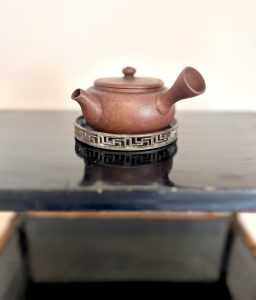

こちらの錫製のお品は使い込まれた味わいがあり、縁の装飾や急須を持ち上げると現れる彫刻の文様が繊細でずっと眺めていられます。先ほどトレイだと思っていたと綴りましたが、ジュエリーなど何か綺麗なものも置いてみたくなります。
世界最古の錫器は3500年前のものとされており、レオナルド・ダ・ビンチの「最後の晩餐」にも錫の食器が描かれるなど古くから人々に親しまれてきたようです。日本には遣唐使によって1300年前に伝来したとされています。
錫は酸化しにくく錆びにくい金属として知られ、美しい光沢を長期間に渡り保ち続けることから、古くから装飾品としても用いられてきました。
錆びにくいという特性から有害物質が溶け出さず、また抗菌作用もあるためお酒や水を浄化するとされ神様に捧げる進物としても使われてきたとのこと。
錫は割れない金属だそうですが、純度100%のものは非常に柔らかく強い圧力で変形することもあるとのこと。しかし元通りにも戻せるという特性から長く使うことができ、現在では錫の特性を生かした多くの製品が作られています。融点が低いため冷たいものは冷たく、温かいものは温かいまま保つことができるため食器にも最適な素材とされています。
個人的には金銀とは違う独特の柔らかな輝きに魅力を感じます。
以前、錫製の茶壺を頂いたのですが引っ越しの際に無くなってしまいました。その時は価値も分からず、持ち運ぶのに重いなぁと扱いにくささえ感じていましたので、紛失してもあまり残念に思っておりませんでした。
現金なもので今頃どこにいるのか気になっております。
それでは、また次の機会に。
Hello everyone. This is Staff H.
My morning routine these days is to watch the Paralympic Games and check the path of typhoons.
I was almost late again this morning because I couldn’t help but watch the Paralympic athletes in action. Personally, I am looking forward to watching “Boccia”.
Speaking of typhoons, every day I am amazed at the places where they stay. This morning it was over the Pacific Ocean. I feel as if I am at the mercy of an adolescent child. Actually, this typhoon is named “shansahan,” after a little girl in Hong Kong.
Typhoons used to be named after people in English by the United States, but since 2000, typhoons in the Northwest Pacific and South China Sea have been given names that are familiar to Asians. The aim is to raise people’s awareness of disaster prevention by naming typhoons with familiar names.
Ten Asian-style names were proposed from each country, for a total of 140 names. The names will be chosen in order from among them. The names vary from country to country, and some are unique, such as the name of a candy or the name of a warrior. These seem to be tied to constellations, and according to the Japan Meteorological Agency, they are “familiar names that are neutral, less likely to create conflicts of interest, and associated with typhoons moving through the sky. Compared to countries that name their products after sweets, such as pudding, I feel that it shows the Japanese temperament.
Now, I heard about a nice tray that I have been thinking about for a while. Since I heard that it was a kyusu stand, I had an urge to put a kyusu on it, and today I finally did. I don’t know if the size is right, but when I put it on, it looks so cute. Unfortunately, it did not fit in the trapezoidal kyusu stand…
This tin piece has a used taste, and the decoration on the rim and the carved patterns that appear when the teapot is lifted are so delicate that you can look at them for a long time. I spelled out earlier that I thought it was a tray, but I would love to put something beautiful on it, such as jewelry.
The world’s oldest tinware is said to be 3,500 years old, and people have been familiar with tinware since ancient times, as seen in Leonardo da Vinci’s “The Last Supper” where tinware is depicted. It is said that tin was introduced to Japan 1,300 years ago by Japanese envoys to the Tang Dynasty.
Tin is known as a metal that does not oxidize easily and does not rust easily, and has been used as a decorative item for a long time because it keeps its beautiful luster for a long time.
Because of its resistance to rust, toxic substances do not dissolve out of tin, and because of its antibacterial properties, tin is believed to purify alcohol and water, and has been used as a gift to the gods.
Tin is said to be an unbreakable metal, but 100% pure tin is very soft and can be deformed by strong pressure. However, its ability to be restored to its original shape allows it to be used for a long time, and today many products are made using tin’s characteristics. Because of its low melting point, it can keep cold things cold and warm things warm, making it an ideal material for tableware.
Personally, I am attracted to its unique soft shine, which is different from that of gold and silver.
I once received a tin tea pot, but it was lost when I moved. At the time, I didn’t know the value of it and even felt it was heavy to carry and difficult to handle, so I wasn’t too disappointed when it was lost.
I am wondering where it is now because I am a cash cow.
I will see you next time.
*******************
ご実家の整理やお片付けなどをされている方のご相談などが多くございます。
お片付けなどくれぐれもご無理のないようになさってくださいませ。
風光舎では古美術品や骨董品の他にも絵画や宝石、趣味のお品など様々なジャンルのものを買受しております。
お片付けをされていて、こういうものでもいいのかしらと迷われているものでも、どうぞお気軽にご相談下さいませ。
また風光舎は、出張買取も強化しております。ご近所はもちろん、愛知県内、岐阜県、三重県その他の県へも出張いたします。
なお、毎月21日の持込鑑定会では無料鑑定・買取・ご相談など、ご予約なしで承っております。
ご近所の皆さま、ご遠方のみなさまも、お気軽にお越しくださいませ。
まずは、お電話お待ちしております。
愛知県名古屋市千種区姫池通
骨董 買取【古美術 風光舎 名古屋店】
TEL052(734)8444
10:00-18:00 OPEN
#出張買取#骨董#古美術#骨董品#絵画#版画#茶道具#刀剣#彫刻

